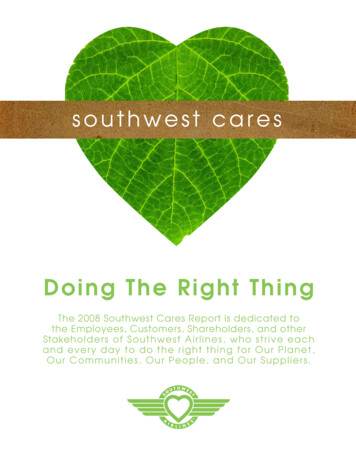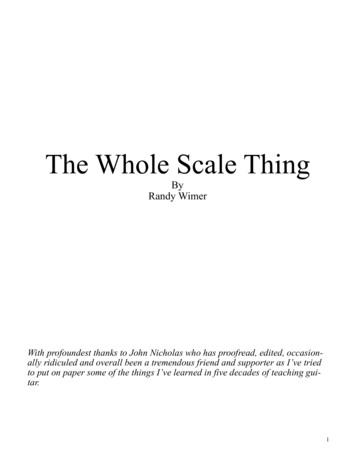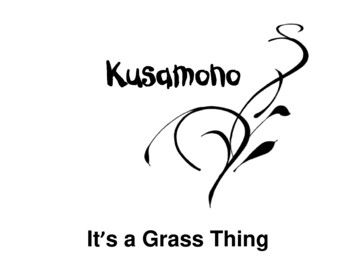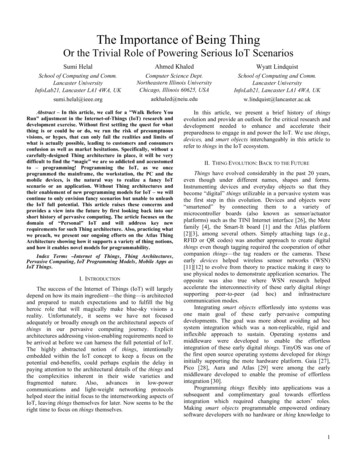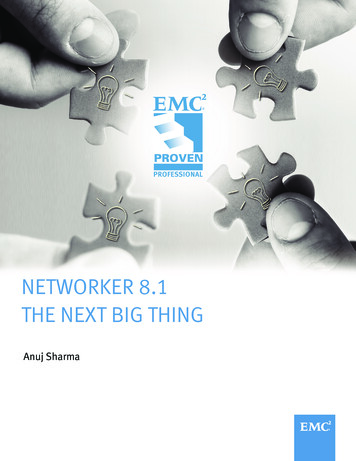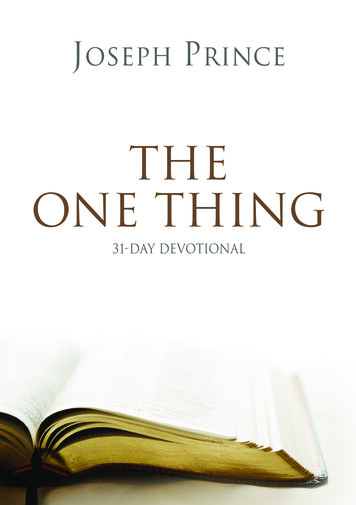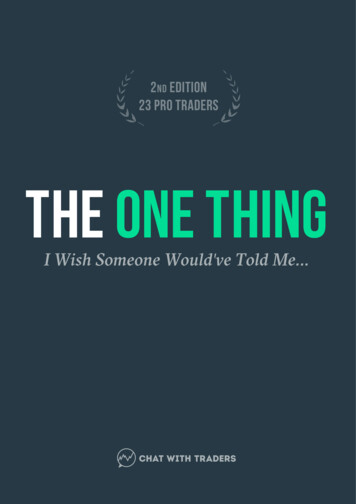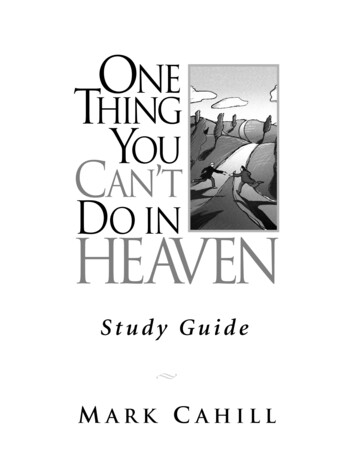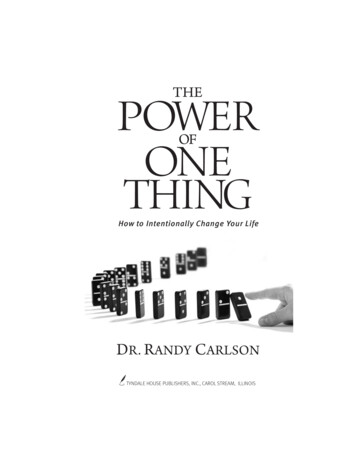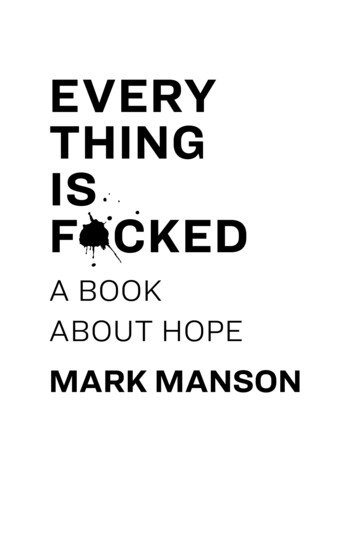
Transcription
EVERYTHINGISF CKEDA BOOKABOUT HOPEMARK MANSON
everything is fucked.Copyright 2019 by Mark Manson. All rights reserved. Printed in the United States of America. No part of this book maybe used or reproduced in any manner whatsoever without written permission except in the case of brief quotations embodied in critical articles andreviews. For information, address HarperCollins Publishers, 195 Broadway,New York, NY 10007.HarperCollins books may be purchased for educational, business, or salespromotional use. For information, please email the Special Markets Department at SPsales@harpercollins.com.first editionDesigned by Leah Carlson- StanisicLibrary of Congress Cataloging- in- Publication Data has been applied for.ISBN 978-0-06-288843-3ISBN 978-0-06-288846-4 (International Edition)19 20 21 22 23 lsc 10 9 8 7 6 5 4 3 2 1
AcknowledgmentsThis book, in many ways, lived up to its title while being written. There were many occasions when it seemed as though everything was irreparably fucked because I had fallen victim to myown overzealous hopes. Yet, somehow— often late at night, withme staring bleary- eyed at a mush of words on my screen— thingscame together. And now I am incredibly proud of the result.I wouldn’t have survived this ordeal without the help and support of a great number of people. My editor, Luke Dempsey, wholived with the same gun to his head for six months (or more) thatI did— you really came through in stoppage time, mate. Thankyou. Mollie Glick, who is more like a fairy godmother at this pointthan an agent— I wake up, and amazing shit just appears in mylife out of nowhere. It’s incredible. To my Web team, Philip Kemper and Drew Birnie, who continue to make me appear far morecompetent and knowledgeable than I actually am— I’m extremelyproud of what the three of us have built online and I can’t wait tosee what you two are capable of in coming years.And then there’s the smattering of friends who showed up bigwhen it counted: Nir Eyal— for getting me up and writing duringmany frigid New York mornings when I could easily have stayedin bed. Taylor Pearson, James Clear, and Ryan Holiday— for listening to me vent and ramble and freak out when I needed to(which was fairly often) and for patiently offering advice. PeterShallard, Jon Krop, and Jodi Ettenberg— for dropping everythingto read some maimed chapter and then sending me notes andfeedback. Michael Covell— for being a top- shelf bro. And WS, who1
Acknowledgmentssomehow managed to be both the cause and solution to this wholefucking mess— you were an unexpected inspiration without eventrying to be. “The trick is you bite off more than you can chew . . .and then you chew it.”I’d be remiss if I did not give a shout out the NYC Chapter ofthe Gentleman’s Literary Safari— how could I have known that anerdy book club started in my kitchen last summer would regularly be the highlight of my month? Much of this book was bornfrom those long philosophical meanderings with you guys. Thankyou. And remember, lads: “Being is always the being of a being.”And finally, to my wonderful wife, Fernanda Neute. I could fillan entire page with superlatives about this woman and how muchshe means to me, and every single one of them would be true. ButI will spare the ink and extra paper— just as she would want— and keep it short. Thank you for the gift of commitment and self- limitation. If I’m ever able to hope for nothing, it will be for thesimple reason that I’m already with you.2
NotesChapter 1: The Uncomfortable Truth1. A. J. Zautra, Emotions, Stress, and Health (New York: Oxford UniversityPress, 2003), pp. 15–22.2. I don’t use the word hope in this book in the way it is typically used academically. Most academics use “hope” to express a feeling of optimism: anexpectation of or belief in the possibility of positive results. This definitionis partial and limited. Optimism can feed hope, but it is not the same thingas hope. I can have no expectation for something better to happen, but I canstill hope for it. And that hope can still give my life a sense of meaning andpurpose despite all evidence to the contrary. No, by “hope,” I am referringto a motivation toward something perceived as valuable, what is sometimesdescribed as “purpose” or “meaning” in the academic literature. As a result,for my discussions of hope, I’ll draw on research on motivation and valuetheory and, in many cases, try to fuse them together.3. M. W. Gallagher and S. J. Lopez, “Positive Expectancies and MentalHealth: Identifying the Unique Contributions of Hope and Optimism,”Journal of Positive Psychology 4, no. 6 (2009): 548–56.4.This is almost certainly an overstatement.5.See Ernest Becker, The Denial of Death (New York: Free Press, 1973).6. Am I allowed to cite myself? Fuck it, I’m going to cite myself. See MarkManson, “7 Strange Questions That Help You Find Your Life Purpose,” MarkManson.net, September 18, 2014, https://markmanson.net/life-purpose.7. For data on religiosity and suicide, see Kanita Dervic, MD, et al., “Religious Affiliation and Suicide Attempt,” American Journal of Psychiatry161, no. 12 (2004): 2303–8. For data on religiosity and depression, see Sasan Vasegh et al. “Religious and Spiritual Factors in Depression,” Depression Research and Treatment, published online September 18, 2012, doi:10.1155/2012/298056.8. Studies done in more than 132 countries show that the wealthier acountry becomes, the more its population struggles with feelings of meaning and purpose. See Shigehiro Oishi and Ed Diener, “Residents of PoorNations Have a Greater Sense of Meaning in Life than Residents of WealthyNations,” Psychological Science 25, no. 2 (2014): 422–30.3
Notes9. Pessimism is widespread in the wealthy, developed world. When thepublic opinion data company YouGov surveyed people in seventeen countries in 2015 on whether they believed the world was getting better, worse,or staying the same, fewer than 10 percent of people in the richest countriesbelieved it was getting better. In the United States, only 6 percent said itwas getting better. In Australia and France, that figure was only 3 percent.See Max Roser, “Good News: The World Is Getting Better. Bad News: YouWere Wrong About How Things Have Changed,” World Economic Forum,August 15, 2018, -about-how-things-have-changed.10. The books I refer to are Steven Pinker’s Enlightenment Now: The Casefor Reason, Science, Humanism, and Progress (New York: Viking, 2018), andHans Rosling’s Factfulness: Ten Reasons We’re Wrong About the World—AndWhy Things Are Better Than You Think (New York: Flatiron Books, 2018).I needle the authors a bit here, but these are two excellent and importantbooks.11. This “corner to corner” phrase is a riff on Andrew Sullivan’s excellentpiece on this same topic. See Andrew Sullivan, “The World Is Better ThanEver. Why Are We Miserable?” Intelligencer, March 9, 2018.12. Max Roser and Esteban Ortiz-Ospina, “Global Rise of Education,” published online at OurWorldInData.org, 2018, n.13. For an exhaustive treatment of the historical reduction in violence,Pinker’s book is indispensable. See Steven Pinker, The Better Angels of OurNature: Why Violence Has Declined (New York: Penguin Books, 2012).14. Pinker, Enlightenment Now, pp. 214–32.15. Ibid., pp. 199–213.16. “Internet Users in the World by Regions, June 30, 2018,” pie chart,InternetWorldStats.com, https://www.internetworldstats.com/stats.htm.17. Diana Beltekian and Esteban Ortiz-Ospina, “Extreme Poverty Is Falling:How Is Poverty Changing for Higher Poverty Lines?” March 5, 2018, OurWorldInData.org, ty-lines.18. Pinker, The Better Angels of Our Nature, pp. 249–67.19. Pinker, Enlightenment Now, pp. 53–61.20. Ibid., pp. 79–96.21. Vaccinations are probably the single greatest advancement of humanwell-being in the past one hundred years. One study found that the WHO’sglobal vaccination campaign in the 1980s likely prevented more than twenty4
Notesmillion cases of dangerous diseases worldwide and saved 1.53 trillion inhealth care costs. The only diseases ever eradicated entirely were eradicateddue to vaccines. This is part of why the antivaccination movement is so infuriating. See Walter A. Orenstein and Rafi Ahmed, “Simply Put: VaccinationsSave Lives,” PNAS 114, no. 16 (2017): 4031–33.22. G. L. Klerman and M. M. Weissman, “Increasing Rates of Depression,”Journal of the American Medical Association 261 (1989): 2229–35. See also J. M.Twenge, “Time Period and Birth Cohort Differences in Depressive Symptoms in the U.S., 1982–2013,” Social Indicators Research 121 (2015): 437–54.23. Myrna M. Weissman, PhD, Priya Wickramaratne, PhD, Steven Greenwald, MA, et al., “The Changing Rates of Major Depression,” JAMA Psychiatry 268, no. 21 (1992): 3098–105.24. C. M. Herbst, “‘Paradoxical’ Decline? Another Look at the RelativeReduction in Female Happiness,” Journal of Economic Psychology 32 (2011):773–88.25. S. Cohen and D. Janicki-Deverts, “Who’s Stressed? Distributions ofPsychological Stress in the United States in Probability Samples from 1983,2006, and 2009,” Journal of Applied Social Psychology 42 (2012): 1320–34.26. For a harrowing and impassioned analysis of the opioid crisis rippingthrough North America, see Andrew Sullivan, “The Poison We Pick,” NewYork Magazine, February 2018, ioid-epidemic.html.27. “New Cigna Study Reveals Loneliness at Epidemic Levels in America,”Cigna’s Loneliness Index, May 1, 2018, gna-us-loneliness-survey/.28. The Edelman Trust Index finds a continued decline in social trustacross most of the developed world. See “The 2018 World Trust Barometer: World Report,” les/2018-10/2018 Edelman Trust Barometer Global Report FEB.pdf.29. Miller McPherson, Lynn Smith-Lovin, and Matthew E. Brashears, “Social Isolation in America: Changes in Core Discussion Networks over TwoDecades,” American Sociological Review 71, no. 3 (2006): 353–75.30. Wealthier countries, on average, have higher suicide rates than poorercountries. Data can be found from the World Health Organization, “Suicide Rates Data by Country,” DR?lang en. Suicide is also more prevalent in wealthier neighborhoods compared with poorer neighborhoods. See Josh Sanburn, “WhySuicides Are More Common in Richer Neighborhoods,” Time, November 8,2012, re-more-common-in-richer-neighborhoods/.5
Notes31. Each of these is true, by the way.32. My three-part definition of hope is a merging of theories on motivation,value, and meaning. As a result, I’ve kind of combined a few different academic models to suit my purposes.The first is self-determination theory, which states that we require threethings to feel motivated and satisfied in our lives: autonomy, competence,and relatedness. I’ve merged autonomy and competence under the umbrellaof “self-control” and, for reasons that will become clear in chapter 4, restyledrelatedness as “community.” What I believe is missing in self- determinationtheory—or, rather, what is implied but never stated—is that there is something worth being motivated for, that there is something valuable in theworld that exists and deserves to be pursued. That’s where the third component of hope comes in: values.For a sense of value or purpose, I’ve pulled from Roy Baumeister’smodel of “meaningfulness.” In this model, we need four things to feel thatour life is meaningful: purpose, values, efficacy, and self-worth. Again, I’velumped “efficacy” under the “self-control” umbrella. The other three, I’ve putunder the umbrella of “values,” things we believe to be worthwhile and important and that make us feel good about ourselves. Chapter 3 will dissect atlength my understanding of values. To learn more about self- determinationtheory, see R. M. Ryan and E. L. Deci, “Self-Determination Theory and theFacilitation of Intrinsic Motivation, Social Development, and Well- being,”American Psychologist 55 (2000): 68–78. For Baumeister’s model, see RoyBaumeister, Meanings of Life (New York: Guilford Press, 1991), pp. 29–56.Chapter 2: Self-Control Is an Illusion1. Elliot’s case is adapted from Antonio Damasio, Descartes’ Error: Emotion,Reason, and the Human Brain (New York: Penguin Books, 2005), pp. 34–51.Elliot is the pseudonym given to the patient by Damasio.2. This and many of the examples from his family life (Little League games,Family Feud, etc.) are fictionalized simply to illustrate the point. They are notfrom Damasio’s account and probably didn’t happen.3. Ibid., p. 38. Damasio uses the term free will, whereas I use the termself-control. Both can be thought of in self-determination theory as the needfor autonomy (see Damasio, Descartes’ Error, chap. 1, note 32).4. Waits muttered the joke on Norman Lear’s television show Fernwood 2Night in 1977, but he didn’t come up with it. Nobody knows where the jokeoriginated, and if you try to find out online, you’ll lose yourself down a rabbithole of theories. Some have credited the joke to the writer Dorothy Parker,others to comedian Steve Allen. Waits himself claimed he didn’t rememberwhere he first heard it. He also admitted that the joke wasn’t his.6
Notes5. Some early frontal lobotomies actually used icepicks. Walter Freeman,the biggest proponent of the procedure in the United States, used icepicksexclusively before moving away from them because too many were breakingoff and getting stuck inside patients’ heads. See Hernish J. Acharya, “TheRise and Fall of Frontal Leucotomy,” in W. A. Whitelaw, ed., The Proceedingsof the 13th Annual History of Medicine Days (Calgary: University of Calgary,Faculty of Medicine, 2004), pp. 32–41.6.Y
Notes Chapter 1: The Uncomfortable Truth 1. J. Zautra, A Emotions, Stress, and Health (New York: Oxford University Press, 2003), pp. 15–22. 2. I don’t use the word hope in this book in the way it is typically used ac- ademically. Most academics use “hope” to express a feeling of optimism: an

